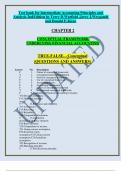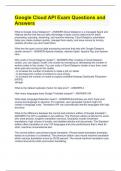Exam (elaborations)
Test bank for Intermediate Accounting Principles and Analysis 2nd Edition by Terry D.Warfield ,Jerry J.Weygandt and Donald E.Kieso CHAPTER 2 CONCEPTUAL FRAMEWORK UNDERLYING FINANCIAL ACCOUNTING .
- Institution
- Intermediate Accounting Principles
Test bank for Intermediate Accounting Principles and Analysis 2nd Edition by Terry D.Warfield ,Jerry J.Weygandt and Donald E.Kieso CHAPTER 2 CONCEPTUAL FRAMEWORK UNDERLYING FINANCIAL ACCOUNTING TRUE-FALSE—Conceptual (QUESTIONS AND ANSWERS) Answer No. Description F 1. Nature of conc...
[Show more]




